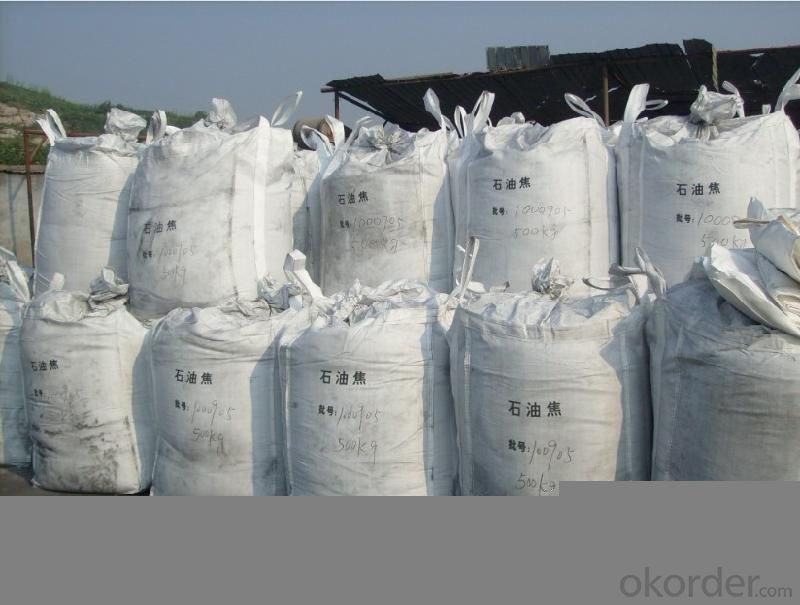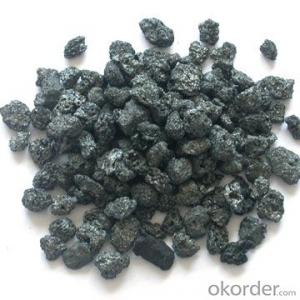Low sulfur Calcined Petroleum Coke of CNBM in China
- Loading Port:
- Tianjin
- Payment Terms:
- TT OR LC
- Min Order Qty:
- 1 m.t.
- Supply Capability:
- 10000000 m.t./month
OKorder Service Pledge
OKorder Financial Service
You Might Also Like
1.Structure of Calcined Petroleum Coke Description
Calcined Petroleum Coke is made from raw petroleum coke,which is calcined in furnace at a high temperature(1200-1300℃).CPC/Calcined Petroleum Coke is widely used in steelmaking,castings manufacture and other metallurgical industry as a kind of recarburizer because of its high fixed carbon content,low sulfur content and high absorb rate.Besides,it is also a best kind of raw materials for producing artifical graphite(GPC/Graphitized Petroleum Coke) under the graphitizing temperature(2800℃).
2.Main Features of the Calcined Petroleum Coke
High-purity graphitized petroleum coke is made from high quality petroleum coke under a temperature of 2,500-3,500°C. As a high-purity carbon material, it has characteristics of high fixed carbon content, low sulfur, low ash, low porosity etc.It can be used as carbon raiser (Recarburizer) to produce high quality steel,cast iron and alloy.It can also be used in plastic and rubber as an additive.
3. Calcined Petroleum Coke Images


4. Calcined Petroleum Coke Specification
classify | Ash ,% (≤) | volatiles,% (≤) | water,% (≤) | sulfur,% (≤) |
High sulfur coke | 0.8 | 0.5 | 0.3 | 0.8 |
Mid Sulfur coke | 0.5 | 0.5 | 0.3 | 0.5 |
Low sulfur coke | 0.3 | 0.5 | 0.3 | 0.3 |
5.FAQ of Calcined Petroleum Coke
1). Q: Are you a factory or trading company?
A: We are a factory.
2). Q: Where is your factory located? How can I visit there?
A: Our factory is located in ShanXi, HeNan, China. You are warmly welcomed to visit us!
3). Q: How can I get some samples?
A: Please connect me for samples
4). Q: Can the price be cheaper?
A: Of course, you will be offered a good discount for big amount.
- Q: What can light hydrocarbon carbon five be packed with?
- The stove is rated 1000 + 200Pa, outdoor transmission and distribution pipe network according to the number of users determine the diameter of the smallest diameter, 108mm diameter, maximum diameter 325mm, are made of seamless steel pipe or special gas PE pipe, outdoor pipe network by welding or hot melt connection method, the indoor pipeline for galvanized pipe, mainly adopts threaded connection. The design and construction are the same as that of the natural gas pipeline network. If the natural gas is replaced, it can be butted with the natural gas pipe mouth, and the indoor and outdoor pipe network need not make any change.
- Q: What is diamond?
- Diamond is a naturally occurring precious gemstone that is composed of carbon atoms arranged in a unique crystal lattice structure, known for its exceptional hardness, brilliance, and durability.
- Q: What is the carbon emission of the air conditioner?
- Summer less air-conditioning 1 hours, it will reduce carbon emissions of 0.621kg
- Q: Why vegetarianism can reduce carbon emissions?
- This specific or calculated, and if you have done ISO14064, you should know that every year will be the carbon emissions statistics, the general is your year of all activities in accordance with the corresponding CO2 coefficients into CO2 equivalent;If you eat according to statistics, that is to calculate what you eat, how much CO2 is needed to produce;
- Q: How are carbon nanotubes used in various applications?
- Carbon nanotubes possess remarkable versatility and have discovered countless applications across diverse fields. In the realm of electronics, they serve as an alternative to conventional silicon-based materials, thereby facilitating the creation of smaller, faster, and more efficient devices. They function as the fundamental components for transistors, interconnects, and memory devices. Within the energy sector, researchers are exploring the potential of carbon nanotubes to enhance battery and supercapacitor performance. Their exceptional electrical conductivity and expansive surface area render them ideal for augmenting energy storage and expediting charge and discharge rates. Moreover, carbon nanotubes find utility in the realm of materials science. By incorporating them into composites, it is possible to bolster their strength, rigidity, and electrical conductivity. These composites prove valuable in the aerospace, automotive, and construction industries, where lightweight and durable materials are in high demand. Furthermore, carbon nanotubes are under investigation for their medical applications. Thanks to their distinct properties, they can be utilized in drug delivery systems, sensors, and imaging technologies. They possess the ability to selectively target cancer cells, thereby enabling more efficient and precise treatment alternatives. To summarize, carbon nanotubes offer an extensive array of applications, ranging from electronics and energy storage to materials science and medicine. Their exceptional properties make them highly coveted for enhancing performance and driving advancements across various industries.
- Q: What are the impacts of carbon emissions on ecosystems?
- Ecosystems are significantly affected by carbon emissions, and their consequences can be observed at various levels of the food chain. One of the primary effects is the modification of the climate, as carbon emissions contribute to global warming and climate change. This alteration in temperature and weather patterns can disturb ecosystems and result in the depletion of biodiversity. Moreover, increased carbon emissions also play a role in ocean acidification, a process in which seawater absorbs carbon dioxide, leading to a reduction in pH levels. This can have harmful impacts on marine life, especially organisms that possess calcium carbonate shells like corals, mollusks, and specific plankton species. As the acidity of the oceans intensifies, it becomes more difficult for these organisms to produce and maintain their protective shells, ultimately causing a decline in their populations. Additionally, carbon emissions have the potential to influence the distribution and behavior of species. With rising temperatures, certain habitats become unsuitable for some species, compelling them to either migrate or adapt to new conditions. This can disrupt the fragile equilibrium of ecosystems, as some species may struggle to find sufficient resources or face heightened competition for limited resources in their new environments. Furthermore, carbon emissions have a significant impact on the frequency and intensity of extreme weather events such as hurricanes, droughts, and wildfires. These occurrences can result in the destruction of habitats, loss of vegetation, and displacement of species, ultimately affecting the overall well-being and stability of ecosystems. In conclusion, the effects of carbon emissions on ecosystems are profound and far-reaching. It is imperative to reduce these emissions and transition to cleaner sources of energy in order to mitigate these consequences and safeguard the delicate balance of our natural world.
- Q: What's the difference between blue and red Panasonic batteries (carbon)?
- Blue is leak, proof, general, Purpose, general use battery (leak proof)Red is the long life long life battery (suitable for watches and clocks and other small power appliances)And heavy duty green seems to be good for high power appliances, such as toy cars
- Q: How do you distinguish between alkaline and ordinary carbon cells?
- Look at the identification of a cylindrical battery. Alkaline battery categories identified as LR, such as "LR6" as the No. 5 alkaline battery, "LR03" is the No. 7 alkaline battery; ordinary dry cell categories identified as R, such as "R6P" for high power 5 ordinary batteries, "R03C" type No. 7 for high capacity batteries.
- Q: How can we reduce carbon emissions from transportation?
- We can reduce carbon emissions from transportation by promoting the use of electric vehicles, improving public transportation infrastructure, encouraging carpooling and cycling, implementing stricter fuel efficiency standards, and investing in renewable energy sources for vehicles. Additionally, adopting more sustainable transportation policies and practices, such as telecommuting and promoting walkable communities, can significantly contribute to reducing carbon emissions.
- Q: What is sintered carbon?
- The process of choosing appropriate process and operating systems in accordance with the internal laws of the sintering process, the use of modern scientific and technological achievements, strengthening sintering production process, to obtain advanced technical and economic indicators, to ensure the realization of high yield, high quality and low consumption. The production process has the raw materials, against the ash, mixing, crushing and screening, crushing and screening solvent fuel proportioning, mixing, ignition, exhaust ventilation cooling, sintering, crushing and screening, dust and other aspects.
Send your message to us
Low sulfur Calcined Petroleum Coke of CNBM in China
- Loading Port:
- Tianjin
- Payment Terms:
- TT OR LC
- Min Order Qty:
- 1 m.t.
- Supply Capability:
- 10000000 m.t./month
OKorder Service Pledge
OKorder Financial Service
Similar products
Hot products
Hot Searches




























